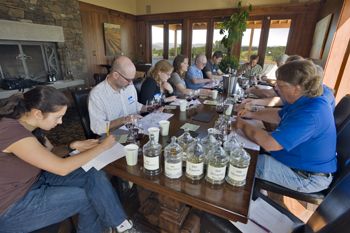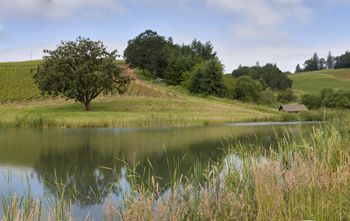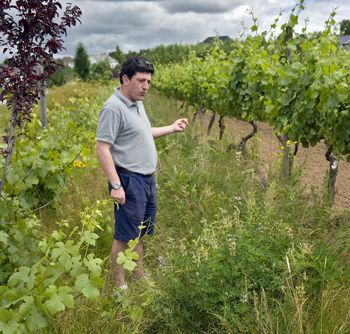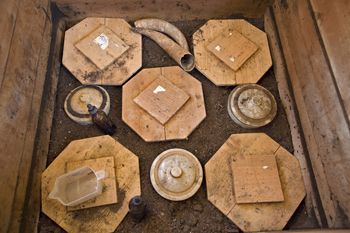Holistic Taste Test




Story and Photos by Janis Miglavs
Back in the 1920s, the founder of the Waldorf School, Rudolf Steiner, developed a rigorous farming system called Biodynamics. In a nutshell, it’s organic farming, which prohibits the use of synthetic pesticides and herbicides but with an overlay of Steiner’s holistic philosophy and the use of homeopathic-like preparations. Today, an increasing number of Oregon vineyards and wineries are adopting Steiner’s intensive techniques, which require extra labor and expense.
So is it possible to actually taste a difference in the wines coming from Biodynamic vineyards as opposed to more traditionally farmed ones? According to a panel of 12 sophisticated tasters involved in a triangular blind tasting, the answer is: Yes.
EXPERIMENT
To get to our test results, we needed an experiment where all of the variables are eliminated except the one being tested, which in this case is wine made from fruit farmed Biodynamically and another farming method. Variables such as AVA, soils, vineyard orientation, grape variety and even winemaking techniques must be exactly the same.
So, where to find such conditions? Doe Ridge Vineyard in Yamhill Carlton-District.
The southeast-facing vineyard near Carlton is split by a natural wooded gully and contains only Willakenzie soil. With the advice of consultants, the owners, Steve Black and family of The Four Graces winery, planted the same clones on the same rootstock of Pinot Noir on both sides of the gully. But one side of the 44-acre vineyard is farmed as certified LIVE (Low Input Viticulture and Enology) and the other half as Biodynamic. Everything is kept separate on each side, even the farm equipment.
Although the managers and winemaker say it could happen any day, Doe Ridge is not yet Demeter certified. (Demeter is the international organization certifying vineyards and wineries as Biodynamic, with the U.S. chapter headquartered in Philomath, Ore.)
Laurent Montalieu, owner of Grand Cru Estates, Soléna Estate and NW Wine Company, was both a Doe Ridge vineyard consultant and winemaker for wines coming from both sides. Since he used the same techniques in making the wine, our tasting situation was as scientifically identical as possible in a production situation.
When I approached Montalieu and Anthony Van Nice, general manager at The Four Graces, about doing a comparison taste test, they not only consented, but also were enthusiastic about it.
TASTE TEST
On July 8, 12 tasters — ranging from advanced beginners to very experienced — gathered at Grand Cru Estates to participate in the triangular blind tasting. There were three flights with three glasses in each. To make it a triangular test, two of the glasses contained the same wine in each flight. Participants wrote detailed tasting notes about 11 characteristics including color, aroma, taste/flavors, mouthfeel/texture and finish.
Immediately after the tasting, we did a hand count to determine how many people correctly identified the single wine. Looking at the matrix, the majority of tasters were able to differentiate between Biodynamic and LIVE practices.
While descriptors varied wildly, some trends stood out. Even though they did not know the vintage, many noted that the 2008 flight seemed “more finished” compared to the 2009 flight. Although tasters disagreed upon the description, they agreed on which wine was different.
For example, finish for Biodynamic wines in flight three, one taster wrote “abrupt” while another noted “long and fruity.” Yet, each taster used the same description for both Biodynamic glasses and a different note for the LIVE.
Overall, there is no doubt that the tasting panel detected differences between Biodynamic- and LIVE-sourced wines.
What exactly did the Waldorf School founder want farmers to do?
Besides the philosophy and preparations he suggested using, Steiner believed that it’s possible to know things that go beyond what can be weighed, measured and calculated.
But exactly what is it about Biodynamic that makes the wine distinguishably different from sustainable LIVE? Probably the best way to begin the search is to put on your wine lover’s sift-through-the-evidence pith helmet to sort through how Oregonians are using the practices. To simplify the process, we will look at four principles as roughly outlined by Alan York, Biodynamic consultant to many vineyards and wineries.
WHOLE FARM
Steiner’s idea was to have the entire property as an integrated farm with as few outside inputs as possible. For example, a vineyard property would also have acres of wheat to feed the cows, which in turn provide manure for compost. Vegetables would be grown to feed the workers and forestland would provide the wood for buildings. The idea is to try to create a closed system.
Sam Tannahill, director of viticulture and winemaking at Rex Hill/A to Z Wineworks, grows animated when he talks about his Biodynamic plans.
“We’re planting black locust trees that we will be using as vineyard endposts. Next year we’re planting a European white oak for barrels 20 years from now. We’re planting buckwheat because it has the highest nectar contact of any plant available for insects, and we’re putting up hawk perches.
“That’s what I like about Biodynamics; it talks about building, creating and making the land better than what we have today.”
Biodiversity
A key element in Biodynamics is biodiversity. The ultimate vineyard would be five rows of vines, a nice swath of tomatoes and then another five rows of vines, all mixed with corn or beans.
Nice goal, but with hillside property more and more expensive, vineyards have become a monoculture crop. Anyone who has taken a hot air balloon trip over the Dundee Hills will see a wall-to-wall carpet of vines. But there are ways to create biodiversity with wildlife preserves and wildlife corridors on the property and cover crops between the rows of vines.
Kevin Chambers, owner of Resonance Vineyard and director of Oregon Vineyard Supply, explains how he is restoring five acres of oak savannah at the bottom of his Carlton-area vineyard to closely mimic the savannah that once covered most of the Willamette Valley.
“This oak savannah is now alive with bugs, critters and all kinds of plant species that I believe really helps aid the notion of biodiversity in the vineyard,” Chambers explained. “Bugs will move in and out of that border environment into the vineyard and then back out.
“One of the things that clearly happens in a monoculture is we breed our own insect problems over time,” he added. “There was a period, 10 to 15 years ago, when insect issues didn’t exist. Now they do.
“For example, the problem we started to face in 2002, here in the valley, was rust mites. I believe that was created or exacerbated by the removal of all the underbrush and blackberries, the hideout for bug predators. And that’s why we see such a problem with that pest in the Dundee Hills. On my own site, I don’t think I have any rust mites, not because I do anything so uniquely different in the vineyard, but because I keep this biologically diverse surrounding where the predators live.”
PREPARATIONS
Here’s where we lose some vineyard growers who roll their eyes at the thought that a thimble-full of something can keep an entire vineyard healthy. Steiner recommended the use of nine specific preparations to be used in miniscule doses like homeopathic vaccinations or stimulants. These include silica, yarrow, chamomile (yes, the same stuff some drink as a tea), nettle, valerian, horsetail (the ancient plant found along roadsides), dandelion, oak bark and cow manure buried to compost in a cow horn.
Wait a minute … bury bovine dung in a cow horn for months to compost? Here I would like to respond.
As someone who has gardened with compost for 50 years, what I’ve seen come out of that horn is the richest, sweetest compost I have ever seen or smelled. Amazingly, even John Locke, the 17th century English philosopher who greatly influenced our founding fathers, wrote in his travel journal that the French buried sheep horns in their vineyards. Perhaps Steiner’s ideas are not all that original.
The preparations — two sprayed directly in the vineyard, the other seven applied to a compost pile to be spread in the vineyard — seem to work in practical ways.
Bill Steele and his wife, Barbara, of Cowhorn Vineyard & Garden, the only certified organic and Biodynamic winery in Southern Oregon, speak casually about their 117-acre Biodynamic farm.
“So the Grenache gets a few more applications of the silica spray than the Viognier, especially during the cooler years,” Bill explained. “The ground silica is like a million little mirrors on the grape leaves, focusing the sunlight to aid photosynthesis. So in a cool year, the 501 — Steiner’s name for the silica preparation — gives a little boost. It won’t get us from 21 to 25 brix, but 22.5 to 23 is helpful.”
LIVING ORGANISM
Biodynamic practitioners manage the land as a living organism with a holistic view rather than focus just on specific things like one crop, animal or disease.
For psychiatrist Bob Gross, owner of Cooper Mountain in Beaverton, Oregon’s first Biodynamic-certified vineyard and winery, concern for both the environment and the effect of drugs and chemicals on his patients led him to Steiner.
In his Hawaiian-style shirt, Gross’s voice changes from monotone to animated when he recalls his experiences with the FDA-approved spray called Mesurol — a chemical that makes birds vomit while eating grapes. He was told that as long as he sprayed at least two weeks before harvest, there was no residual on the grapes. Great. This would prevent birds from eating the fruit.
“It turns out it’s a neurotoxin and small amounts of it went undetected in the wine that everyone was drinking,” Gross explained. “So it made me really think about what chemicals we are using. And that we can’t just assume that all the chemicals the FDA says are OK for people, are in fact OK.”
That’s when Gross started working with consultant Alan York.
“First he starts looking at the shrubs, plants and flowers. And I thought it really had nothing to do with the grapes. Then we went out to the field. Alan was interested in the ecosystem of the plant and the planet. You are not just treating the plant, you are treating the soil, the leaves and the whole way the plant interfaces with the soil and atmosphere. It’s a whole system.”
Chambers, on the other hand, explains his Biodynamic understanding in slightly different terms.
“I was attracted to Biodynamics because I wanted to grow better grapes to make the best possible wine,” he said. “I am increasingly fascinated, yet perplexed by the spirituality of the whole process.”
He enthusiastically goes on and on about Quantum mechanics, String Theory and how mass is just concentrated energy. “I think Biodynamics is playing in that arena, where science meets spirituality.”
DOES IT WORK?
Chambers chuckles when asked if the extra work of Biodynamics is worth the effort. He tells of meeting John Reganold, a Washington State University professor who in the mid to late ’90s did a series of experiments.
He wanted to prove that Biodynamics was legitimate. So, he set up trials with different crops using conventional farming, organic farming and Biodynamic farming. He did the full regimen in each of the sites. After a few years of doing this research, Chambers recalls the professor saying, “I don’t know what is going on here, but I can tell you that in every case in my trials, the Biodynamic farmed sites have healthier soils.”
CONCLUSION
So is it healthier soils, compost-aged sprays, more attention to the vineyard that resulted in the differences detected by our tasters in the wine? Go forth to conduct your own taste test to see for yourself. I would enjoy hearing your theory about the taste difference.
Janis Miglavs photographs Portland, Oregon, Pacific Northwest, world-wide architecture, vineyards, wineries, landscapes and writes vineyard photography books that win international awards.









